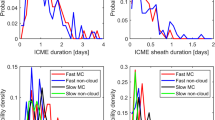Abstract
Magnetic clouds (MCs) frequently show abnormal high-ionization states of heavy ions. The abnormal high-charge distributions are related to the coronal temperature of their source regions. We examined the plasma and magnetic field data of 74 MCs observed by the Advanced Composition Explorer from February 1998 to December 2008. We determined that 14 of the 74 events showed local high-temperature phenomena. We analyzed the correlation between proton temperature and O7/O6 ratio (or high mean Fe charge state 〈Fe〉) within the local high-temperature regions in the 14 MCs. Results show that proton temperature and O7/O6 ratio (or high mean Fe charge state) had good correlations in nine MCs, but had no evident correlation in the other five MCs. The local high-temperature phenomena within the nine MCs have resulted from the Sun.
Similar content being viewed by others
References
Burlaga L F, Sittler E, Mariani F, Schwenn R. 1981. Magnetic loop behind an interplanetary shock: Voyager, Helios, and IMP 8 observations. J Geophys Res, 86: 6673–6684
Burlaga L F, Skong R M, Smith C W, Webb D F, Zurbuchen T H, Reinard A. 2001. Fast ejecta during the ascending phase of solar cycle 23: ACE observations, 1998–1999. J Geophys Res, 106: 20957–20978
Bothmer V, Schwenn R. 1996. Signatures of fast CMEs in interplanetary space. Adv Space Res, 17: 319–322
Feng H Q, Wu D J, Chao J K, Lee L C, Lyu L H. 2010. Are all leading shocks driven by magnetic clouds? J Geophys Res, 115: A04107
Feng H Q, Wang J M. 2014. Magnetic reconnection as a possible heating mechanism of the local high temperature protons within magnetic clouds. Sci China Earth Sci, 57: 1979–1985, doi: 10.1007/s11430- 013-4816-x
Henke T, Woch J, Mall U, Livi S, Wilken B, Schwenn R, Gloeckler G, von Steiger R, Forsyth R J, Balogh A. 1998. Differences in the O7+/O6+ ratio of magnetic cloud and non-cloud coronal mass ejections. Geophys Res Lett, 25: 3465–3468
Lepping R P, Burlaga L F, Jones J A. 1990. Magnetic field structure of interplanetary magnetic clouds at 1 AU. J Geophys Res, 95: 11957–11965
Lepri S T, Zurbuchen T H, Fisk L A, Richardson I G, Cane H V, Gloeckler G. 2001. Iron charge distribution as an identifier of interplanetary coronal mass ejections. J Geophys Res, 106: 29231–29238
Lepri S T, Zurbuchen T H. 2004. Iron charge state distributions as an indicator of hot ICMEs: Possible sources and temporal and spatial variations during solar maximum. J Geophys Res, 109: A01112
Li H J, Feng X S, Xiang J, Zuo P B. 2013. New approach for solving the inverse boundary value problem of Laplace’s equation on a circle: Technique renovation of the Grad-Shafranov (GS) reconstruction. J Geophys Res, 118: 2876–2881
Marubashi K, 2000. Physics of interplanetary magnetic flux ropes: Towards prediction of magnetic storms. Adv Space Res, 26: 55–66
Nakagawa T, Matsuoka A. 2010. Fitting a toroidal force-free field to multispacecraft observations of a magnetic cloud. J Geophys Res, 115: A10113
Reinard A. 2005. Comparison of interplanetary CME charge state composition with CME-associated flare magnitude. Astrophys J, 620: 501–505
Richardson I J, Cane H V. 2004a. The fraction of interplanetary coronal mass ejections that are magnetic clouds: Evidence for a solar cycle variation. Geophys Res Lett, 31: L18804
Richardson I J, Cane H V. 2004b. Identification of interplanetary coronal mass ejections at 1 AU using multiple solar wind plasma composition anomalies. J Geophys Res, 109: A09104
Wang Y M, Ye P Z, Wang S, Xue X H. 2003a. An interplanetary cause of large geomagnetic storms: Fast forward shock overtaking preceding magnetic cloud. Geophys Res Lett, 30: 1700
Wang Y M, Ye P Z, Wang S, Xiong M. 2003b. Theoretical analysis on the geoeffectiveness of a shock overtaking a preceding magnetic cloud. Sol Phys, 216: 295–310
Wu D J, Chao J K, Lepping R P. 2000. Interaction between an interplanetary magnetic cloud and the Earth’s magnetosphere: Motions of the bow shock. J Geophys Res, 105: 12627–12638
Xiong M, Zheng H N, Wang S. 2009. Magnetohydrodynamic simulation of the interaction between two interplanetary magnetic clouds and its consequent geoeffectiveness: 2. Oblique collision. J Geophys Res, 114: A11101
Xiong M, Zheng H N, Wu S T, Wang Y M, Wang S. 2007. Magnetohydrodynamic simulation of the interaction between two interplanetary magnetic clouds and its consequent geoeffectiveness. J Geophys Res, 112: A11103
Zuo P B, Wei F S, Feng X S, Yang F. 2007. The Relationship between the magnetic cloud boundary layer and the substorm expansion phase. Sol Phys, 242: 167–185
Author information
Authors and Affiliations
Corresponding author
Rights and permissions
About this article
Cite this article
Wang, J., Feng, H. Observational connection between local high-temperature phenomena within magnetic clouds and the Sun. Sci. China Earth Sci. 59, 1051–1056 (2016). https://doi.org/10.1007/s11430-016-5275-y
Received:
Accepted:
Published:
Issue Date:
DOI: https://doi.org/10.1007/s11430-016-5275-y




